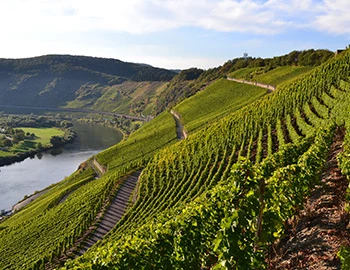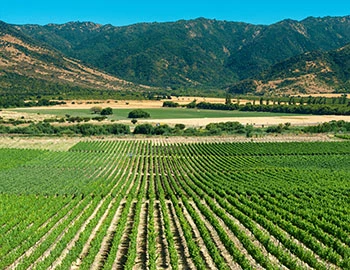Loire
Loire: the regal wine river
The French refer to the river landscape of the Loire simply as “the garden of France.” It is no wonder that kings and the nobility built their magnificent chateaux here. At the same time, the Loire is a highly varied wine river. From Pouilly-sur-Loire in the east, to Nantes at the river’s outlet, into the Atlantic, the vineyards follow the river's course and yield highly distinctive wines from varieties such as Sauvignon Blanc, Chenin Blanc, Muscadet and the red Cabernet Franc..
White wines from Loire
The Loire is the longest of the French rivers to flow into the Atlantic. It originates in the Massif Central, near the Rhône valley watershed, and discharges into the Atlantic 1,000 kilometres to the northwest, near Nantes. Along the final 500 kilometres, it is almost entirely lined with vineyards. In total, there are over 50,000 hectares planted with vines on the Loire and its numerous tributaries.
Crisp to noble sweet
The easternmost winegrowing region includes Sancerre and Pouilly-sur-Loire, where very straightforward, dry and crisp wines are produced from Sauvignon Blanc, with green-herb and mineral notes. From here, this variety has set its sights on worldwide success. The westerly tip of the Loire, the region of Nantes, where the river flows into the Atlantic, is also considered a stronghold of dry white wines. The light and extremely crisp Muscadet wines are vinified from the Melon de Bourgogne variety. Between these eastern- and westernmost vineyards, the Loire brings forth a vast multitude of wines from various varieties and with various styles. The robust Cabernet Franc growths from Chinon, for example, are well-known, as are the rosé wines from Anjou. After Sauvignon Blanc, Chenin Blanc is considered the second great white variety. Especially in Savennières, it yields expressive wines with a rather dry style. Meanwhile, in Vouvray and in the Coteaux du Layon appellation (in the province of Anjou), superb noble sweet “Moelleux” wines are produced. The sparkling wines (Crémant de Loire) are also often impressive.
A puzzle of terroirs
As the Loire passes through a large tract of France from west to east, the climate is highly diverse. Humid Atlantic air masses flow eastward along the river’s central and side valleys, until they gradually lose their influence in the elevations of Touraine. No later than Vouvray, and in particular in the upper Loire, a continental climate is increasingly identifiable. Soil conditions also vary from place to place. Near the river, vines are often rooted in alluvial deposits of gravel and sand. At higher sites, especially in Saumur, Chinon and Vouvray, pronouncedly more porous and geologically younger, calcareous tufa predominates.
The Gauls and the Romans were the first to practice viticulture on the Loire. By the 8th century the cultivation area had expanded massively. The Benedictine monks of the Cluny abbey in Burgundy were among the vinicultural pioneers in the Loire’s east, in Sancerre and Pouilly.








